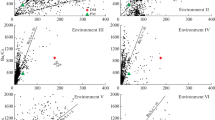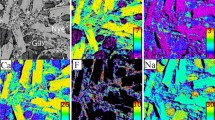Abstract
Oligocene volcanics from Oatlands in Tasmania, Australia, include olivine tholeiites, alkali olivine basalts, nepheline basanites and olivine nephelinites. They have compositional characteristics that are typical of intraplate basalts worldwide. They are generally enriched in incompatible elements relative to the primitive mantle and are strongly enriched in Nb, Ta and light rare earths, but not heavy rare earths. At the same time, they have Sr and Nd isotope compositions that are similar to those in some incompatible-element-depleted mid-ocean ridge basalts (E-type MORB). Experimentally obtained mineral/melt partition coefficients for an Oatlands basanite allow the relative concentrations of incompatible elements in the volcanics to be produced by small degrees of melting (≤1%) of a source similar to the E-type MORB source of Workman and Hart (2005). However, the absolute concentrations that can be achieved in this way are much less than present in the most incompatible-element-enriched basanites and nephelinites at Oatlands. This contradiction can be explained by open-system melting under the influence of a conductive geotherm. This would have involved upwardly migrating near-solidus melts from the asthenosphere cooling along a sub-adiabatic geotherm. Cooling of the melts would have caused them to re-crystallize and accumulate in the overlying mantle, thereby enriching both the new host rocks and any residual melts in incompatible elements. This would also have increased the buoyancy of the host rocks leading to upwelling and further (decompression) melting of incompatible-element-enriched peridotite. We were able to use our partition coefficients to quantitatively model the development of incompatible-element enrichments in the Oatlands magmas by these processes. Our explanation is consistent with the characteristically scattered but widespread distributions and long time scales of intraplate volcanism in a broad variety of tectonic settings. This is because the conditions required to initiate volcanism (i.e. those of near-solidus melting of the asthenosphere) are relatively easy to produce and can therefore be caused by both near-surface tectonics and deeper mantle processes. Furthermore, the super-enrichments of incompatible elements in some intraplate volcanics can be attributed to the influence of normal geothermal gradients on melting processes. Without the very strong fractionation imposed by this combination of factors, the Oatlands volcanics would more closely resemble mid-ocean-ridge basalts.









Similar content being viewed by others
References
Adam J (1990) The geochemistry and experimental petrology of sodic alkaline basalts from Oatlands, Tasmania. J Petrol 31:1201–1223
Adam J, Green TH (2006) Trace element partitioning between mica- and amphibole-bearing garnet lherzolite and hydrous basanitic melt: 1. experimental results and the investigation of controls on partitioning behaviour. Contrib Mineral Petrol 152:1–17
Afonso JC, Zlotnik S, Fernàndez M (2008) Effects of compositional and rheological stratifications on small-scale convection under the oceans: implications for the thickness of ocean lithosphere and seafloor flattening. Geophys Res Lett 35:L20308. doi:10.1029/2008GL035419
Albarède F (1995) Introduction to geochemical modelling. Cambridge, Cambridge University Press, p 543
Aldanmaz E, Köprübaşi N, Gürer ÖF, Kaymakçi N, Gourgaud A (2006) Geochemical constraints on the Cenozioc, OIB-type alkaline volcanic rocks of NW Turkey: implications for mantle sources and melting processes. Lithos 86:50–76
Bailey DK (1982) Mantle metasomatism—continuing chemical change within the Earth. Nature 296:525–530
Ballmer MD, van Hunen J, Ito G, Bianco TA, Tackley PJ, Bianco TA (2007) Non-hotspot volcano chains originating from small-scale sublithospheric convection. Geophysic Res Lett 34:L23310. doi:10.1029/2007GL031636
Ballmer MD, van Hunen J, Ito G, Bianco TA, Tackley PJ (2009) Intraplate volcanism with complex age-distance patterns: a case for small-scale sublithospheric convection. Geochem Geophys Geosystems 10:Q06015. doi:10.1029/2009GC002386
Barker DS, Mitchel RH, McKay D (1987) Late Cretaceous nephelinite to phonolite magmatism in the Balcones province, Texas. Geol Soc Am Special paper 215:293–304
Berry RF, Banks MR (1985) Striations on minor faults and the structure of the Parmeener Super-group near Hobart, Tasmania. Papers Proc Royal Soc Tasmania 119:23–29
Beyer, EE (2002) Evolution of the lithosphere beneath Tasmania and western Norway. Unpublished Ph. D. thesis Macquarie University, Australia
Bourdon B, Henderson GM, Lundstrom CC, Turner SP (2003) Uranium series geochemistry. Reviews in mineralogy and geochemistry, vol 52. Geochemical Society-Mineralogical Society of America, Washington, p 656
Buck R (1986) Small scale convection induced by passive rifting: the cause for uplift of rift shoulders. Earth Planet Sci Lett 77:362–372
Cas RAF (1989) Physical volcanology. In: Johnson RW (ed) Intraplate volcanism in eastern Australia and New Zealand, chapter 2. Cambridge University Press, Cambridge, pp 55–83
Chen C-Y, Frey FA, Rhodes JM, Garcia MO (1996) Temporal geochemical evolution of Kilauea Volcano: composition of Hilina and Puna basalt. In: Basu A, Hart S (eds) Earth processes: reading the isotopic code. Geophysical Monograph, American Geophysical Union 95:161–181
Choi SH, Mukasa SB, Kwon S-T, Andronikov AV (2007) Sr, Nd, Pb and Hf isotopic compositions of late Cenozoic alkali basalts in South Korea: evidence for mixing between the two dominant asthenospheric mantle domains beneath East Asia. Chemical Geology 232:134–151
Chung S-L, Sun S-S, Tu K, Chen C-H, Lee C-Y (1994) Late Cainozoic basaltic volcanism around the Taiwan Strait, SE China: product of lithosphere-asthenosphere interaction during continental extension. Chemical Geology 112:1–20
Clague DA, Frey FA (1982) Petrology and trace element geochemistry of the Honolulu Volcanics, Oahu: implications for the oceanic mantle below Hawaii. J Petrol 23(3):447–504
Cohen AS, O’Nions RK, Kurz MD (1996) Chemical and isotopic variations in Mauna Loa tholeiites. Earth Planet Sci Lett 143:111–124
Demidjuk Z, Turner S, Sandiford M, George R, Foden J, Etheridge M (2007) U-series isotope and geodynamic constraints on mantle melting processes beneath the Newer Volcanic Province in South Australia. Earth Planet Sci Lett 261:517–533
Duncan RA, McDougall I (1989) Volcanic time-space relationships. In: Johnson RW (ed) Intraplate volcanism in eastern Australia and New Zealand. Cambridge University Press, Cambridge, pp 43–53
Dupuy C, Barsczus H, Dostal J, Vidal P, Liotard J (1989) Subducted and recycled lithosphere as the mantle source of ocean island basalts from southern Polynesia, Central Pacific. Earth Planet Sci Lett 114:477–489
Eggins SM (1992a) Petrogenesis of Hawaiian tholeiites: 1, phase equilibria constraints. Contrib Mineral Petrol 110:387–397
Eggins SM (1992b) Petrogenesis of Hawaiian tholeiites: 2, aspects of dynamic melt segregation. Contrib Mineral Petrol 110:398–410
Eggins SM, Woodhead JD, Kinsley LPJ, Mortimer GE, Sylvester P, McCulloch MT, Hergt JM, Handler MR (1997) A simple method for the precise determination of ≥40 trace elements in geological samples by ICPMS using enriched isotope internal standardization. Chem Geol 134:311–326
Ferguson EM, Klein EM (1993) Fresh basalts from the Pacific-Antarctic Ridge extend the Pacific geochemical province. Nature 366:330–333
Frey FA, Green DH, Roy SD (1978) Integrated models of basalt petrogenesis: a study of quartz tholeiites to olivine melilitites from South Eastern Australia utilizing geochemical and experimental data. J Petrol 19:463–513
Frey FA, Clague D, Mahoney JJ, Sinton JM (2000) Volcanism at the edge of the Hawaiian plume: petrogenesis of submarine alkalic lavas from the North Arch volcanic field. J Petrol 41:667–691
Goes S, Simons FJ, Yoshizawa K (2005) Seismic constraints on temperature of the Australian uppermost mantle. Earth Planet Sci Lett 236:227–237
Green DH (1989) Experimental petrology. In: Johnson RW (ed) Intraplate volcanism in eastern Australia and New Zealand, chapter 7.5. Cambridge University Press, Cambridge, pp 321–324
Green DH, Liebermann RC (1976) Phase equilibria and elastic properties of a pyrolite model for the oceanic upper mantle. Tectonophysics 32:61–92
Green DH, Ringwood AE (1967) The genesis of basaltic magmas. Contrib Mineral Petrol 15:103–190
Halliday AN, Lee D-C, Tommasini S, Davies GR, Paslick CR, Fitton JG, James DE (1995) Incompatible trace elements in OIB and MORB and source enrichment in the sub-oceanic mantle. Earth Planet Sci Lett 133:379–395
Hirschman MM, Kogiso T, Baker MB, Stolper EM (2003) Alkalic magmas generated by partial melting of garnet pyroxenite. Geology 31:481–484
Hoang N, Flower M (1998) Petrogenesis of Cenozoic basalts from Vietnam: implications for origins of a “diffuse igneous province”. J Petrol 39:369–395
Hofman AW, White WM (1982) Mantle plumes from ancient oceanic crust. Earth Planet Sci Lett 57:421–436
Hofmann AW, Feigenson MD (1983) Case studies on the origin of basalt: I. theory and reassessment of Grenada basalts. Contrib Mineral Petrol 84:382–389
Ito E, White WM, Gopel C (1987) The O, Sr, Nd and Pb isotope geochemistry of MORB. Chem Geol 62:157–176
Janousek V, Erban V, Holub FV, Magna T, Bellon H, Mlčoch B, Wiechert U, Rapprich V (2010) Geochemistry and genesis of behind-arc basaltic lavas from eastern Nicaragua. J Vol Geotherm Res 192:232–256
Johnson RW (1989) Intraplate volcanism in Eastern Australia and New Zealand. Cambridge University Press, Cambridge
Kamenetsky VS, Everard JL, Crawford AJ, Varne R, Eggins SM, Lanyon R (2000) Enriched end-member of primitive MORB melts: petrology and geochemistry of glasses from Macquarie Island (SW Pacific). J Petrol 41:411–430
Kampunzu AB, Lubala RT (1991) Magmatism in extensional structural settings: the Phanerozoic African plate. Springer-Verlag, Berlin, p 637
Knutson J, Sun S-S, Ewart A (1989) In: Johnson RW (ed) Intraplate Volcanism in eastern Australia and New Zealand. Cambridge University Press, Cambridge, chapter 7.4 pp. 313–320
Lister GS, Etheridge MA (1989) Detachment models for uplift and volcanism in the eastern highlands, and their application to the origin of passive margin mountains. In: Johnson RW (ed) Intraplate volcanism in eastern Australia and New Zealand. chapter 7.3. Cambridge University Press, Cambridge, pp 297–307
Liu J, Han J, Fyfe S (2001) Cenozoic episodic volcanism and continental rifting in northeast China and possible link to Japan Sea development as revealed by K-Ar geochronology. Tectonophysics 339:385–401
McDonough WF, Sun S-S (1995) The composition of the Earth. Chem Geol 120:223–253
McDonough WF, McCulloch MT, Sun S-S (1985) Isotopic and geochemical systematics in Tertiary-Recent basalts from southeastern Australia and implications for the evolution of the sub-continental lithosphere. Geochim Cosmochim Acta 49:2051–2067
McKenzie DP (1984) The generation and compaction of partially molten rock. J Petrol 25:713–765
Moll-Stalcup EJ (1994) Latest Cretaceous and Cenozoic magmatism in mainland Alaska. In: Plafker G, Berg HC (eds) The geology of Alaska. The geology of North America, vol G-1. Geological Society of America, Boulder, pp 589–619
Moll-Stalcup EJ (1995) The origin of the Bering Sea basalt province, western Alaska. In: Simakov, KV, Thurston DK (eds) 1994 Proceedings: International conference on Arctic Margins. Russian Academy of Sciences Far East Branch North East Science Center, Magadan, Russia, pp. 113–123
Morgan WJ (1971) Convection plumes in the lower mantle. Nature 230:42–43
Nickel KG, Green DH (1985) Empirical geothermobarometry for garnet peridotites and implications for the nature of the lithosphere, kimberlites and diamonds. Earth Planet Sci Lett 73:158–170
Nixon PH (1987) Mantle xenoliths. John Wiley & Sons, New York
O’Reilly SY, Griffin WL (1985) A xenolith derived geotherm for southeastern Australia and its geophysical implications. Tectonophysics 111:41–63
O’Reilly SY, Zhang M (1995) Geochemical characteristics of lava-field basalts from eastern Australia and inferred sources: connections with the subcontinental lithospheric mantle? Contrib Mineral Petrol 121:148–170
Ormerod DS, Rogers NW, Hawkesworth CJ (1991) Melting in the lithospheric mantle: inverse modelling of alkali-olivine basalts from the Big Pine Volcanic Field, California. Contrib Mineral Petrol 108:305–317
Pfänder JA, Münker C, Stracke A, Mezger K (2007) Nb/Ta and Zr/Hf in ocean island basalts–Implications for crust-mantle differentiation and the fate of Nb. Earth Planet Sci Lett 254:158–172
Pilet S, Hernandez J, Sylvester P, Poujol M (2005) The metasomatic alternative for ocean island basalt chemical heterogeneity. Earth Planet Sci Lett 236:148–166
Pin C, Francisco J, Zalduegui S (1997) Sequential separation of light rare-earth elements, thorium and uranium by miniaturized extraction chromatography: application to isotopic analyses of silicate rocks. Anal Chim Acta 339:79–89
Putirka KD, Pelt M, Ryerson FJ, Jackson MG (2007) Ambient and excess mantle temperatures, olivine thermometry, and active vs. passive upwelling. Chem Geol 241:177–206
Pyle DG, Christie DM, Mahoney JJ, Duncan RA (1995) Geochemistry and geochronology of ancient southeast Indian and southwest Pacific seafloor. J Geophys Res 100:22261–22282
Raddick MJ, Parmentier EM, Scheirer (2002) Buoyant decompression melting: a possible mechanism for intraplate volcanism. J Geophys Res 107(B10):228. doi:10.1029/2001JB000617
Richter FM (1986) Simple models for trace element fractionation during melt segregation. Earth Planet Sci Lett 77:333–344
Ringwood TE (1966) The chemical composition and origin of the earth. In: Hurley PM (ed) Advances in earth science, pp 287–356
Roden MF, Frey FA, Clague DA (1984) Geochemistry of tholeiitic and alkalic lavas from the Koolau Range, Oahu, Hawaii: implications for Hawaiian volcanism. Earth Planet Sci Lett 69:141–158
Roeder PL, Emslie RF (1970) Olivine-liquid equilibria. Contrib Mineral Petrol 29:275–289
Salters VJM, Longhi JE, Bizimis M (2002) Near mantle solidus trace element partitioning at pressures up to 3.4 GPa. Geochem. Geophys. Geosyst 3 (paper number 2001GC000148)
Schminke HU (1982) Volcanic and chemical evolution of the Canary Islands. In: von Rad U, Hinz K, Sarnthein M, Seibold E (eds) Geology of the Northwest African continental margin. Heidelberg, Springer Verlag, pp 273–306
Shaw D (2006) Trace elements in Magmas. Cambridge University Press, Cambridge
Sobolev AV, Hofmann AW, Sobolev SV, Nikogosian IK (2005) An olivine-free mantle source of Hawaiian shield basalts. Nature 434:590–597
Sun S-S, Hanson GN (1975) Origin of Ross Island basanitoids and limitations upon the heterogeneity of mantle sources for alkali basalts and nephelinites. Contrib Mineral Petrol 52:77–106
Sun S-S, McDonough WF (1989) Chemical and isotopic systematics of oceanic basalts: implications for mantle composition and processes. Geol Soc Special Publication 42:313–345
Sutherland FL (1984) Cainozoic basalts. In Forsyth SM (ed) Geological atlas 1:50 000 series sheet, Oatlands. Geological survey of Tasmanian—Explanatory report
Sutherland FL, Wellman P (1986) Potassium-argon ages of Tertiary volcanic rocks, Tasmania. Pap Proc R Soc Tasmania 120:77–86
Sutherland FL, Hollis JD, Barron LM (1984) Garnet lherzolite and other inclusions from a basalt flow, Bow Hill, Tasmania: Proceedings 3rd Int Kimberlite Conference vol 2, pp 145–160 Elsevier, Amsterdam
Thomas LE, Hawkesworth CJ, Van Calsteren P, Turner SP, Rogers NW (1999) Melt generation beneath ocean islands: a U-Th-Ra isotope study from Lanzarote in the Canary Islands. Geochim Cosmochim Acta 63:4081–4099
Thorkelson DJ, Smith AD (1989) Arc and intraplate volcanism in the Spences Bridge Group: implications for Cretaceous tectonics in the Canadian Cordillera. Geology 17:1093–1096
Thorpe RS (1977) Tectonic significance of alkaline volcanism in Mexico. Tectonophysics 40:19–26
Varne R (1970) Hornblende Lherzolite and the upper mantle. Contrib Mineral Petrol 27:45–51
Wagner TP, Grove TL (1998) Melt/harzburgite reaction in the petrogenesis of tholeiitic magma from Kilauea volcano, Hawaii. Contrib Mineral Petrol 131:1–12
Wallace ME, Green DH (1988) An experimental determination of primary carbonatite magma composition. Nature 335:343–346
Weaver BL (1991) The origin of ocean island basalt end-member compositions: trace element and isotope constraints. Earth Planet Sci Lett 104:381–397
Wedepohl KH (1985) Origin of the tertiary basaltic volcanism in the northern Hessian Depression. Contribs Mineral Petrol 89:122–143
Wells PRA (1977) Pyroxene thermometry in complex and simple systems. Contrib Mineral Petrol 62:129–139
Whitford-Stark JL (1987) A survey of Cainozoic volcanism on mainland Asia. Geol Soc America Special Paper 213
Wilkinson JFG, Hensel HD (1991) An analcime mugearite-megacryst association from north-eastern New South Wales: implications for high-pressure amphibole-dominated fractionation of alkaline magmas. Contrib Mineral Petrol 109:240–251
Wilson M, Downes M (1991) Tertiary-Quaternary extension-related alkaline magmatism in western and central Europe. Journal of Petrology 32:811–849
Winer GS, Feeley TC, Cosca MA (2004) Basaltic volcanism in the Bering Sea: geochronology and volcanic evolution of St. Paul Island, Pribilof Islands, Alaska. J Vol Geotherm Res 134:277–301
Workman RK, Hart SR (2005) Major and trace element composition of the depleted MORB mantle (DMM). Earth Planet Sci Lett 231:53–72
Wright TL (1984) Origin of Hawaiian tholeiites: a metasomatic model. J Geophys Res 89-B5:3233–3252
Yaxley GM, Sobolev AV (2007) High-pressure partial melting of gabbro and its role in the Hawaiian magma source. Contrib Mineral Petrol 154:371–383
Zhang M, O’Reilly SY (1997) Multiple source rocks for basaltic rocks from Dubbo, eastern Australia: geochemical evidence for plume-lithospheric mantle interaction. Chem Geol 136:33–54
Zhang M, Stephenson PJ, O’Reilly SY, McCulloch MT, Norman M (2001) Petrogenesis and geodynamic implications of late Cainozoic basalts in North Queensland, Australia: trace-element and Sr-Nd-Pb isotope evidence. J Petrol 42:685–719
Zindler A, Hart S (1986) Chemical geodynamics. An Rev Earth Planet Sci Lett 14:493–571
Zlotnik S, Alfonso JC, Díez P, Fernández M (2008) Small-scale gravitational instabilities under the oceans: implications for the evolution of oceanic lithosphere and its expression in geophysical observables. Philos Mag 88:3197–3217
Acknowledgments
This research was supported by an ARC Small Grant and a Macquarie University small grant to Trevor Green. We thank Dr Norm Pearson, Suzie Elhou and Carol Conning for their assistance with the electron microprobe and LAM ICP-MS analyses. Solution ICP-MS analyses were conducted by Suzie Elhou and Peter Wieland; Sr and Nd isotopes were analysed by Peter Wieland; and Carol Lawson performed the XRF analyses of Cl and Br. This manuscript benefited from comments by Professor Sue O’Reilly, as well as reviews by Dr. Dave Draper and an unknown reviewer. This is publication number XXX in the Australian Research Council National Key Centre for the Geochemical Evolution and Metallogeny of Continents (GEMOC). This study used instrumentation funded by ARC, LIEF and DEST Systematic Infrastructure Grants, Macquarie University and Industry.
Author information
Authors and Affiliations
Corresponding author
Additional information
Communicated by T. L. Grove.
Rights and permissions
About this article
Cite this article
Adam, J., Green, T. Trace element partitioning between mica- and amphibole-bearing garnet lherzolite and hydrous basanitic melt: 2. Tasmanian Cainozoic basalts and the origins of intraplate basaltic magmas. Contrib Mineral Petrol 161, 883–899 (2011). https://doi.org/10.1007/s00410-010-0570-7
Received:
Accepted:
Published:
Issue Date:
DOI: https://doi.org/10.1007/s00410-010-0570-7




